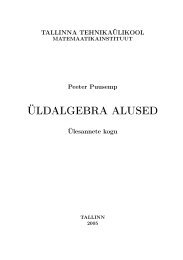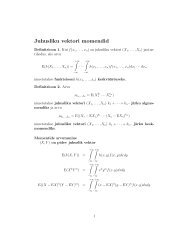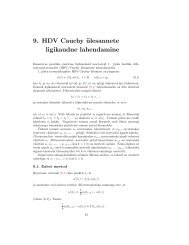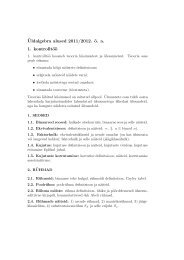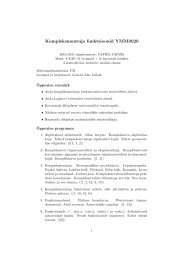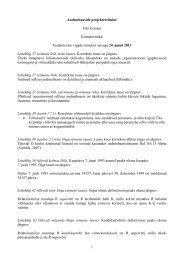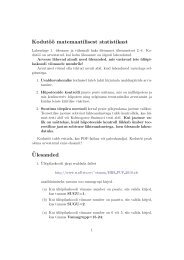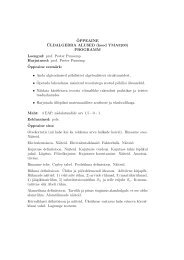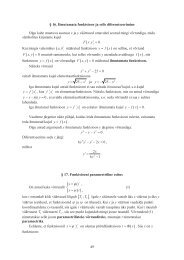π π π
π π π
π π π
Create successful ePaper yourself
Turn your PDF publications into a flip-book with our unique Google optimized e-Paper software.
MATEMAATIKA TÄIENDUSÕPEMÕISTED, VALEMID, NÄITED, ÜLESANDEDLEA PALLASII OSASISUKORD4. TRIGONOMEETRIA …………………………………………………… 514.1 Nurga mõõtmine …………………………………………………………. 514.2 Teravnurga trigonomeetrilised funktsioonid ……………………………. 524.3 Täiendusnurkade trigonomeetrilised funktsioonid ……………………… 534.4 Trigonomeetriliste funktsioonide märgid ja mõned väärtused ………….. 544.5 Trigonomeetriliste funktsioonide perioodid …………………………….. 554.6 Taandamisvalemid. Näited ……………………………………………… 554.7 Trigonomeetria põhivalemid ja nende järeldused. Näited ………………. 574.8 Kahe nurga summa ja vahe trigonomeetrilised funktsioonid …………… 604.9 Kahekordse nurga trigonomeetrilised funktsioonid …………………….. 604.10 Poolnurga trigonomeetrilised funktsiooni ……………………………… 614.11 Summa teisendamine korrutiseks ………………………………………. 614.12 Korrutise teisendamine summaks ………………………………………. 624.13 Näited trigonomeetria valemite rakendamisest …………………………. 624.14 Trigonomeetriliste funktsioonide pöördfunktsioonid (arkusfunktsioonid)....664.15 Arkusfunktsioonid negatiivsest argumendist …………………………… 674.16 Trigonomeetrilised põhivõrrandid. Näited …………………………….. 674.17 Ülesanded trigonomeetriast …………………………………………….. 694. TRIGONOMEETRIA4.1 Nurga mõõtmineTrigonomeetrias mõistetakse nurga all nurga suurust, nurga mõõtarvu. Seetõttu onotstarbekas kujutada nurka kui kiire pöörde suurust ümber oma alguspunkti.Täispööre on 360 ° (kraadi) ehk 2 <strong>π</strong> rad (radiaani). Nurk on positiivne, kui kiirpöördub kellaosuti liikumise vastassuunas. Nurk on negatiivne, kui kiir pöördubkellaosuti liikumise suunas.1Seega 1° on täispöördest ja360360° = 2 <strong>π</strong> rad ,180 ° = <strong>π</strong> rad ,<strong>π</strong>1 ° = rad ,1801 rad ≈ 57,3 ° .51
Järgmises tabelis on tuntumate nurkade väärtused kraadimõõdus jaradiaanmõõdus.α (kraadides) 0° 30° 45° 60° 90° 180° 270° 360°x (radiaanides) 0 <strong>π</strong> <strong>π</strong> <strong>π</strong> <strong>π</strong> <strong>π</strong> 3<strong>π</strong> 2<strong>π</strong>6 4 3 22<strong>π</strong> <strong>π</strong> 2<strong>π</strong>Näiteks 120° = 90 ° +30 ° = + = rad ,2 6 3<strong>π</strong> <strong>π</strong> 5<strong>π</strong>150° = 90 ° +60 ° = + = rad ,2 3 6<strong>π</strong> 7<strong>π</strong>210° = 180 ° +30 ° = <strong>π</strong> + = rad ,6 6<strong>π</strong> 4<strong>π</strong>240° = 180 ° +60 ° = <strong>π</strong> + = rad ,3 3<strong>π</strong> 5<strong>π</strong>300° = 360° − 60 ° =2 <strong>π</strong> − = rad ,3 3<strong>π</strong> 11<strong>π</strong>330° = 360° − 30 ° =2 <strong>π</strong> − = rad .6 64.2 Teravnurga trigonomeetrilised funktsioonidTäisnurkse kolmnurga teravnurkade trigonomeetrilised funktsioonid onjärgmised.αcbβaTeravnurga siinus =vastaskaatet a b; sin α = , sin β =hüpotenuus c cTeravnurga koosinus =lähiskaatet b a; cos α = , cos β =hüpotenuus c cTeravnurga tangens =vastaskaatet a b; tan α = , tan β =lähiskaatet b aTeravnurga kootangens =lähiskaatet b a; cot α = , cot β =vastaskaatet a bα + β = 90ehk<strong>π</strong>α + β = .2Näiteks kui täisnurkses kolmnurgas nurk α = 40°, siis nurk β = 90 − 40° = 50°.52
4.3 Täiendusnurkade trigonomeetrilised funktsioonid<strong>π</strong> <strong>π</strong>Täiendusnurkadeks on nurgad, mille summa on , s.t. α + β = .2 2Täiendusnurkade α ja β korralsinα = cos β, cosα = sin β ,1tanα= = cot β ,tan β1tan β = = cot α .tanα<strong>π</strong>Kui on antud teravnurk α , siis selle täiendusnurk on − α ja kehtivad valemid:2⎛ <strong>π</strong> ⎞sin⎜− α ⎟ = cos α ,⎝ 2 ⎠⎛ <strong>π</strong> ⎞cos⎜− α ⎟ = sin α ,⎝ 2 ⎠⎛ <strong>π</strong> ⎞ 1tan ⎜ − α ⎟ = .⎝ 2 ⎠ tanαNäiteks<strong>π</strong> <strong>π</strong>sin = cos ,3 6<strong>π</strong> <strong>π</strong>cos = sin ,4 4<strong>π</strong> 1 <strong>π</strong>tan = = cot .6 <strong>π</strong>tan3353
4.4 Trigonomeetriliste funktsioonide märgid ja mõned väärtusedTäispöörde jagamine veeranditeks:<strong>π</strong>2II veerand I veerand<strong>π</strong>0 (2 <strong>π</strong> , täispööre)III veerand IV veerand3<strong>π</strong>2Funktsioonide sinα , cosα ja tanα märgid sõltuvalt nurgast:sinα cosα tanαJärgmises tabelis on tuntumate nurkade trigonomeetriliste funktsioonideväärtused.α 0° 30° 45° 60° 90° 180° 270° 360°α 0 <strong>π</strong> <strong>π</strong> <strong>π</strong> <strong>π</strong> <strong>π</strong> 3<strong>π</strong> 2<strong>π</strong>6 4 3 22sinα 0 1 2 3 1 0 − 1 02 2 2cosα 1 3 2 1 0 − 1 0 12 2 2tanα 0 331 3 puudub 0 puudub 054
4.5 Trigonomeetriliste funktsioonide perioodidFunktsioonide sinα ja cosα periood on 2<strong>π</strong> , funktsiooni tanα periood on <strong>π</strong> .Seega( n )sin α + 2 <strong>π</strong> = sin α ,( n )cos α + 2 <strong>π</strong> = cos α ,( n )tan α + <strong>π</strong> = tan α ,.milles n∈Z.{ 1; 2; 3; ...}Z = ± ± ±4.6 Taandamisvalemid. NäitedTaandamisvalemite abil saab mistahes nurga trigonomeetrilise funktsiooniteisendada teravnurga trigonomeetriliseks funktsiooniks.1. Kui nurk on negatiivne, siis kasutatakse valemeid( − α )sin = −sin α ,( α )cos − = cos α ,( − α )tan = − tan α .2. Kui nurk on suurem kui 2 <strong>π</strong> , siis lahutatakse kõigepealt perioodi kordne.3. Kui nurk on väiksem kui 2 <strong>π</strong> , siis saab nurgale anda ühe kujudest <strong>π</strong> ± α , 2<strong>π</strong> − α<strong>π</strong> 3<strong>π</strong>või ± α , ± α . Kui taandamisel kasutatakse kujusid <strong>π</strong> ± α ja 2<strong>π</strong> − α , siis2 2<strong>π</strong> 3<strong>π</strong>funktsiooni nimetus ei muutu. Kui aga kasutatakse ± α , ± α , siis siinus2 2asendub koosinusega ja vastupidi ning tangens asendub oma pöördväärtusega.Märk arvestatakse taandatava funktsiooni järgi (vt. 4.4 Trigonomeetrilistefunktsioonide märgid ja mõned väärtused).Taandamisvalemid sisalduvad järgmises tabelis.55
FunktsioonNurk90° ±α 180° ± α<strong>π</strong><strong>π</strong> ± α± α2270° ±α 360° − α3<strong>π</strong>2<strong>π</strong> − α± α2− α( )sin cosα ∓ sinα − cosα − sinαcos ∓ sinα − cosα ± sinα cosαtan 1 ± tanα 1 − tanα∓∓tanαtanαEelnevaid valemeid kasutatakse tavaliselt teravnurga α korral, kuid nad kehtivadka suvalise nurga korral.Näide 1. Leida avaldiseväärtus.( − 570°) ⋅ cos870° − tan( − 660°) ⋅ tan °sin 390° ⋅ sin 510° + cos1110Lahendus. Kõigepealt vabaneme negatiivsest nurgast, siis eraldame nurgasttäispöörde kordse nurga. Seejärel anname nurgale (kui võimalik) kuju 180 ° ± α või360 ° −α ja rakendame taandamisvalemeid.( ) ( )sin 390°⋅ sin 510° + cos − 570° ⋅ cos870° − tan − 660° ⋅ tan1110° == sin 390°⋅ sin 510° + cos570°⋅ cos870° + tan 660°⋅ tan1110° =( ) ( ) ( ) ( )( ) ( )= sin 30° + 360° ⋅ sin 150° + 360° + cos 210° + 360° ⋅ cos 150° + 2⋅ 360° ++ tan 300° + 360° ⋅ tan 30° + 3⋅ 360° == sin 30°⋅ sin150° + cos 210°⋅ cos150° + tan 300°⋅ tan 30° =( ) ( ) ( ) ( )( ) ( ) ( )= sin 30°⋅ sin 180° − 30° + cos 180° + 30° ⋅ cos 180° − 30° + tan 360° − 60° ⋅ tan 30° == sin 30°⋅ sin 30° + − cos30° ⋅ − cos30° + − tan 60° ⋅ tan 30° =21 1 ⎛ 3 ⎞3 1 3 3= ⋅ + ( 3)1 1 02 2 ⎜2 ⎟+ − ⋅ = + − = − =⎝ ⎠ 3 4 4 3Vastus. 0.Näide 2. Lihtsustada avaldissintan( <strong>π</strong> −α)( <strong>π</strong> + α )1 cos⋅⋅⎛<strong>π</strong>⎞ sintan⎜−α⎟⎝ 2 ⎠( 2<strong>π</strong>−α)( −α).Lahendus. Koos taandamisvalemitega rakendame ka täiendusnurga valemitja saame⎛ <strong>π</strong> ⎞ 1tan ⎜ − α ⎟ =⎝ 2 ⎠ tan α56
( − )( )( − )( )sin <strong>π</strong> α 1 cos 2<strong>π</strong> α⋅ ⋅ =tan <strong>π</strong> + α ⎛ <strong>π</strong> ⎞ sin −αtan ⎜ −α⎟⎝ 2 ⎠sinα1 cosα= ⋅ ⋅ =tanα1 −sinαtanαVastus.− cosα.= −1 1sinα⋅ tanα ⋅ cos α= − cos α .tanα⋅ sinα1 1Näide 3. Lihtsustada avaldis( 90° + α ) − cos( 180° + α ) + tan( 270° −α) − tan( 90°−α)sin .Lahendus.Vastus.( α ) ( α ) ( α ) ( α )sin 90° + − cos 180° + + tan 270° − − tan 90° − =1 1= cosα − ( − cosα ) + − = cosα + cosα = 2cos α .tanαtanα2 cosα.4.7 Trigonomeetria põhivalemid ja nende järeldused. Näited( cotα)Kasutame tähistusi ( sinα)nn= cot α .Kehtivad valemidnn= sin α , ( cosα)nn= cos α , ( tanα)nn= tan α ,2 2sin α + cos α = 1,tanα⋅ cotα= 1,sinαtan α = ,cosα1cos α21+ tan α = ,2cosαcot α = ,sinα1+ =sin α21 cot α .257
Näide 1. Lihtsustada avaldis442sin α − cos α + cos α .4 4Lahendus. Avaldise sin α − cos α teguriteks lahutamisel kasutame valemit2 2a − b = a − b a + b , saame( )( )( )2( sin2cos2) ( sin2cos )2cos( )4 4 2 4 4 2sin α − cos α + cos α = sin α − cos α + cos α == α − α ⋅ α + α + α == α − α ⋅ + α = α − α + α = α2 2 2 2 2 2 2sin cos 1 cos sin cos cos sin .Vastus.sin 2 α .3 ⎛ 1 ⎞ 3Näide 2. Tõestada samasus sin β⎜1+ + cos β ( 1+tan β ) = sin β + cos βtan β⎟.⎝ ⎠Lahendus. Lähtume samasuse vasakust poolest. Kui antud samasus(trigonomeetriline avaldis) sisaldab siinus-, koosinus- ja tangensfunktsioone, siis onotstarbekohane avaldada tangensfunktsioonid siinus- ja koosinusfunktsiooni kaudu.Teisenduste 3. reas võtame summa kahest liikmest sulgude ette ühise tegurisin β + cos β .3 ⎛ 1 ⎞ 3 3 ⎛ ⎝sin β cos β ⎞ 3 ⎛ ⎝cos β sin β ⎞sin β ⎜1+ cos β ( 1 tan β ) sin β 1 cos β 1tan β⎟ + + = ⎜ +sin β⎟ + ⎜ + =cos β⎟⎝ ⎠ ⎝ ⎠ ⎝ ⎠23 sin β + cos β23 cos β + sin β= sin β ⋅+ cos β ⋅=sin β 1cos β 1( ) ( ) ( ) ( )sin β sin β cos β cos β cos β sin β sin β cos β sin β cos β2 2 2 2= + + + = + ⋅ + =( )= sin β + cos β ⋅ 1 = sin β + cos β ,m. o. t. t.Näide 3. Tõestada, et1+2sin α ⋅ cosα=22sin α − cos αtanα+ 1.tanα−1Lahendus. Teisendame esmalt samasuse vasakut poolt, asendades murru lugejas221 = sin α + cos α . Seejärel lahutame murru lugeja ja nimetaja teguriteks, kasutadesa + 2ab + b = a + b ning nimetajas valemit2 2lugejas valemit ( ) 2( )( )− = − + . Seejärel taandame ja saame2 2a b a b a b58
α α α α α α= =2 2 2 2sin α − cos α sin α − cos α2 21+ 2sin ⋅ cos sin + cos + 2sin ⋅cos2 2sin α + 2sinα ⋅ cosα + cos α= =2 2sin α − cos α2( sinα+ cosα)=( sinα − cosα ) ( sinα + cosα)1sinα+ cosα=.sinα− cosα1Teisendame antud samasuse paremat poolt, asendadessin αtan α = , saamecosαsinαcosαsinα+ cosα⎝+ 1tanα+ 1 coscosα= α = 1 sinα+ cosα=.sincos αtanα−1α ⎝ sinα− cosα−1sinα− cosαcosαcosα1Antud samasuse vasak ja parem pool on teisendatud üheks ja samakskolmandaks avaldiseks. On teada, et kui kaks suurust on võrdsed ühe ja samakolmandaga, siis on nad võrdsed ka omavahel. Seega on samasus tõestatud.Antud samasust saab tõestada ka üksnes ühe poole teisendamisega. Lähtusimesin α + cosαvasakust poolest ja jõudsime avaldiseni. Jagades selle avaldise lugejasin α − cosαja nimetaja funktsiooniga cos α ( cosα ≠ 0 , sest avaldis sisaldab tan α ), saamesin α + cosα=sin α − cosαsin α+ 1cosα=sin α−1cosαtanα+ 1tanα−1.Saadud avaldis on ühesugune samasuse parema poolega, järelikult samasus ontõestatud.Näide 4. Arvutadatan α väärtus, kui sin α = −0, 6 ja 180° < α < 270°.Lahendus. Avaldametan α trigonomeetrilise funktsiooni sin α kaudu:sin α sin αtanα= =.cosα2± 1−sin αNurk α peab täitma tingimust 180° < α < 270°(III veerandi nurk), seega cos α < 0,s.t. ruutjuure märgi ees tuleb võtta “−”. Asendame sin α = −0, 6 ja saame59
− 0,6 0,6tanα == = 0,75 .2− 1−0,6 0,8Vastus. tan α = 0, 75 .4.8 Kahe nurga summa ja vahe trigonomeetrilised funktsioonid( )sin α + β = sinα cos β + cosα sin β( )sin α − β = sinα cos β − cosα sin β( )cos α + β = cosα cos β − sinα sin β( )cos α − β = cosα cos β + sinα sin βtantantanα+ tan β+ =1 − tanα⋅ tan β( α β )tanα− tan β− =1 + tanα⋅ tan β( α β )4.9 Kahekordse nurga trigonomeetrilised funktsioonidsin 2α = 2sinα ⋅cosα2 2 2 2α = α − α = α − = − αcos 2 cos sin 2cos 1 1 2sin2 tanαtan 2α=21 − tan α60
4.10 Poolnurga trigonomeetrilised funktsioonidα 1−cosαsin = ± 2 2α 1+cosαcos = ± 2 2α 1−cosα 1−cosα sinαtan = ± = =2 1 + cos α sin α 1 + cos ααMärk “+” või “− ”võetakse veerandi järgi, kuhu kuulub nurk 2(vt. 4.4 Trigonomeetriliste funktsioonide märgid ja mõned väärtused).4.11 Summa teisendamine korrutiseksα + β α − βsinα+ sin β = 2sin ⋅cos2 2α + β α − βsinα− sin β = 2cos ⋅sin2 2α + β α − βcosα+ cos β = 2cos ⋅cos2 2α + β α − βcosα− cos β = −2sin ⋅sin2 2sin ( α + β )tanα+ tan β =cosα⋅cosβ( α − β )sintanα− tan β =cosα⋅cosβ2 α1+ cosα= 2cos 22 α1− cosα= 2sin 261
4.12 Korrutise teisendamine summaks1sinα ⋅ sin β = ⎡cos( ) cos ( )2⎣ α − β − α + β ⎤⎦1cosα ⋅ cos β = ⎡cos( ) cos( )2⎣ α − β + α + β ⎤⎦1sinα ⋅ cos β = ⎡sin ( α β ) sin ( α β )2⎣ − + + ⎤⎦tanα+ tan βtanα⋅ tan β =cotα+ cot β4.13 Näited trigonomeetria valemite rakendamisest22Näide 1. Lihtsustada avaldis cos ( + 2β) + sin ( α − 2β) −1Lahendus.α .( α β ) ( α β ) ( α β ) ⎡ ( α β ) ⎤ ( α β ) ( α β )2 2 2 2 2 2cos 2 sin 2 1 cos 2 1 sin 2 cos 2 cos 2+ + − − = + − ⎣ − − ⎦ = + − − =( α β ) ( α β ) ( α β ) ( α β )= ⎡⎣ cos + 2 − cos − 2 ⎤⎦ ⋅ ⎡⎣ cos + 2 + cos − 2 ⎤⎦=α + 2β + α − 2β α + 2β − α + 2β α + 2β + α − 2β α + 2β − α + 2β= −2sin ⋅sin ⋅ 2cos ⋅ cos=2 2 2 2= −2sinα ⋅sin 2β ⋅ 2cosα ⋅ cos 2β = −( 2sinα cosα) ⋅( )2sin 2β ⋅ cos 2β = −sin 2α ⋅sin 4βVastus.− sin 2α ⋅sin4β.Näide 2. Lihtsustada avaldiscos 3α − cos4α− cos5α+ cos6α.Lahendus.62
cos3α− cos4α− cos5α+ cos6α=( cos3α− cos5α) + ( cos6α− cos 4α)3α+ 5α3α− 5α6α+ 4α6α− 4α= −2sin⋅ sin − 2sin ⋅ sin =2 22 2= −2sin 4α⋅ sin( −α) − 2sin 5α⋅ sin α = 2sin α( sin 4α− sin 5α)4α− 5α4α+ 5α⎛ α ⎞ 9α= 2sin α ⋅ 2sin ⋅ cos = 4sin α ⋅ sin ⎜ − ⎟ ⋅ sin =2 2⎝ 2 ⎠ 2α 9α= −4sinα ⋅ sin ⋅sin2 2==Vastus.α 9α− 4sin α ⋅ sin ⋅ sin .2 2cos 2 α 1Näide 3. Tõestada samasus= − sin 2α.α 1 4tan −2 αtan2Lahendus. Lähtume samasuse vasakust poolest. Asendameαsinα 2αtan = ja2 α2 αcos α = cos 2 ⋅ = cos − sin .2 α2 2 2cos2Saame2 2⎛ 2 α 2 α ⎞ ⎛ 2 α 2 α ⎞2cos sin cos sincos α⎜ − ⎟ ⎜ − ⎟2 2 2 2=⎝ ⎠=⎝ ⎠=α 1 α α 2 α 2 αtan − sin cos sin − cos2 αtan2 − 2 2 22 α α α αcos sin sin cos2 2 2 212 22 α 2 α α α 2 α 2 α⎛ ⎞ ⎛ ⎞ α α⎜cos − sin ⎟ ⋅sin cos ⎜cos − sin ⎟ ⋅sincos⎝ 2 2 ⎠ 2 2 ⎝ 2 2 ⎠ 2 2= ==2 α 2 αsin − cos⎛ 2 α 2 α ⎞− cos sin2 2⎜ − ⎟⎝ 2 2 ⎠ 1⎛ α α ⎞ α α ⎛ α α ⎞= −⎜ cos − sin ⎟⋅ sin cos = −cosα⋅ ⋅ ⎜ 2sin cos ⎟ =⎝ 2 2 ⎠ 2 2 2 ⎝ 2 2 ⎠2 2 11 ⎛ α ⎞ 1 1 1 1= −cosα ⋅ sin ⎜ 2⋅ ⎟ = −cosα ⋅ sinα = − ⋅ ⋅ 2sinα cosα = − sin 2 α ,2 ⎝ 2 ⎠ 2 2 2 4m. o. t. t.63
tan α + 45°+ tan − 45°= 2 tan 2 .Näide 4. Tõestada samasus ( ) ( α ) αLahendus. Lähtume samasuse vasakust poolest. Esmalt asendame tangensite summajagatisega ja seejärel nimetajas olevad tegurid nurkade summa ning vahe koosinusevalemitega:sin ( α + 45° + α − 45°)tan ( α + 45° ) + tan ( α − 45° ) = =cos α + 45° cos α − 45°( ) ( )sin 2α= =( cosα cos 45° − sinα sin 45° )( cosα cos 45° + sinαsin 45°)sin 2α= =⎛ 2 2 ⎞⎛ 2 2 ⎞⎜cosα ⋅ − sinα ⋅ ⎟⎜cosα ⋅ + sinα⋅ ⎟⎝ 2 2 ⎠⎝ 2 2 ⎠sin 2α= =2 2( cosα − sinα ) ⋅ ( cosα + sinα)2 2sin 2α2sin 2α= = = 2 tan 2 α ,1 2 2 cos 2( cos α − sin αα)2m. o. t. t.cos 2α1+tanαNäide 5. Lihtsustada avaldis − .1−sin 2α1−tanαsin α22 1+cos 2α1+tanαcos α − sin αLahendus. − =−cosα=221−sin 2α1−tanαsin α + cos α − 2 sin α cosαsin α1−cosαcosα+ sinα(cosα − sin α ) (cosα + sin α ) cosα=1− 1 =2(cosα− sin α )cosα− sinαcosα1cosα + sinα cosα + sinα= − = 0 .cosα − sinα cosα − sinα64
1+sin α 1−sin αNäide 6. Lihtsustada avaldis − .1−sin α 1+sin αLahendus.⎝1+ sinα⎝1−sinα1+ sinα 1− sinα 1+ sinα 1−sinα− = − =1− sinα 1+ sinα 1− sinα 1+sinα( 1+ sinα) − ( 1−sinα)2 2= =( 1− sinα)( 1+sinα)1+ sin α − (1 − sin α ) 2sinα= = = 2 tan α .21−sin α cosαsin αNäide 7. Lihtsustada avaldis− cosα.αsin α − cosαtan2Lahendus.sinαsinαcosαcosαα− = 1 cosαsinα− =⎝+sinα − cosα tan sinα − cosα⋅2 1+cosαsinα= − cosα=sinα 1+ cosα − cosα ⋅sinα( )1+cosαsin α(1 + cos α )= − cosα=sinα + sinα cosα − sinα cosαsin α (1 + cos α )= − cosα = 1+ cosα − cosα= 1.sinα1+cosα+ cos 2α+ cos 3αNäide 8. Lihtsustada avaldis .22 cos α + cosα−1Lahendus.1+cosα+ cos2α+ cos3α=22cos α + cosα−1( 1+cos2α) + ( cosα+ cos3α)2( 2cos α −1)+ cosα=65
2 2 2 2 α + 3α α − 3αsin α + cos α + cos α − sin α + 2cos cos= 2 2 =α α α α( )2 2 22cos − sin + cos + cos22cos α + 2cos 2α cosα 2cos α (cosα + cos 2 α )2 2cos α sin α cosα cos 2α cosα= = = 2cos α.− + +4.14 Trigonomeetriliste funktsioonide pöördfunktsioonid(arkusfunktsioonid)1. arcsin m on absoluutväärtuselt vähim nurk, mille siinus on m:kusjuuressin ( arcsin m)= m ,<strong>π</strong><strong>π</strong>− ≤ arcsin m ≤ ,2 2−1 ≤ m ≤ 1.2. arccos m on vähim mittenegatiivne nurk, mille koosinus on m:kusjuurescos( arccos m)= m ,0 ≤ arccos m ≤ <strong>π</strong> ,−1 ≤ m ≤ 1.3. arctan m on absoluutväärtuselt vähim nurk, mille tangens on m:kusjuurestan ( arctan m)= m ,<strong>π</strong><strong>π</strong>− < arctan m < ,2 2−∞ < m < ∞ .Näiteks1 <strong>π</strong>arcsin = , 2 6<strong>π</strong>arcsin1 = ,22 <strong>π</strong>arccos = , 2 4arccos1 = 0 ,<strong>π</strong>arctan 3 = ,3<strong>π</strong>arctan1 = ,466
4.15 Arkusfunktsioonid negatiivsest argumendistarcsinarccosarctan( m)( m)( − m)− = − arcsin m− = <strong>π</strong> − arccos m= −arctanmNäiteks⎛ 3 ⎞ 3 <strong>π</strong>arcsin⎜− = − arcsin = −2 ⎟,⎝ ⎠ 2 3⎛ 1 ⎞1 <strong>π</strong> 2<strong>π</strong>arccos ⎜ − ⎟ = <strong>π</strong> − arccos = <strong>π</strong> − = ,⎝ 2 ⎠2 3 3⎛ 3 ⎞ 3 <strong>π</strong>arctan⎜− = − arctan = −3 ⎟.⎝ ⎠ 3 64.16 Trigonomeetrilised põhivõrrandid. Näited1. sin x = m . Kui −1 ≤ m ≤ 1, siis( )nx = − 1 arcsin m + n<strong>π</strong>, n ∈Z .2. cos x = m . Kui −1 ≤ m ≤ 1, siisx = ± arccos m + 2 n<strong>π</strong>, n ∈Z .3. tan x = m , m∈R . Siisx = arctan m + n<strong>π</strong>, n ∈Z .Sageli tekivad trigonomeetriliste võrrandite lahendamisel põhivõrrandid, millestrigonomeetrilise funktsiooni väärtus on null. Seepärast on otstarbekohane teada, etsin x = 0 ⇒ x = n<strong>π</strong>,cos x = 0 ⇒<strong>π</strong>x = n<strong>π</strong>+ ,2tan x = 0 ⇒ x = n<strong>π</strong>, n ∈ Z .2Näide 1. Lahendada võrrand sin x = .2Lahendus. Põhivõrrandi lahendivalemist saameVastus. ( )n 2n <strong>π</strong>x = ( − 1) arcsin + n<strong>π</strong>= ( −1 ) ⋅ + n<strong>π</strong>, n ∈ Z .2 4n <strong>π</strong>x = −1 ⋅ + n<strong>π</strong>, n∈ Z .467
⎛ ⎞Näide 2. Lahendada võrrand 2 cos⎜x − <strong>π</strong> ⎟ + 3 = 0 .⎝ 2 3 ⎠Lahendus. Avaldame võrrandist⎛ ⎞ 3cos⎜x − <strong>π</strong> ⎟ = − ,⎝ 2 3 ⎠ 2siis põhivõrrandi lahendivalemist saamex <strong>π</strong> ⎛ ⎞⎜3− = ± arccos ⎟−+ 2 n<strong>π</strong>, n ∈ Z .2 3 ⎝ 2 ⎠⎛ 3 ⎞3 <strong>π</strong> 5<strong>π</strong>Kuna arccos⎜⎟− = <strong>π</strong> − arccos = <strong>π</strong> − =2,⎝ ⎠2 6 6saamex <strong>π</strong> 5<strong>π</strong>− = ± + 2n<strong>π</strong>,2 3 6x <strong>π</strong> 5<strong>π</strong>= ± + 2n<strong>π</strong>⋅ 2 ,2 3 62<strong>π</strong>5<strong>π</strong>x = ± + 4n<strong>π</strong>, n ∈ Z .3 3Üldlahendis on ühe liikme ees kaks märki, seega saame lahendid esitada kaheseeriana:2<strong>π</strong>5<strong>π</strong>7<strong>π</strong>x1= + + 4n<strong>π</strong>= + 4n<strong>π</strong>,3 3 32<strong>π</strong>5<strong>π</strong>x2= − + 4n<strong>π</strong>= −<strong>π</strong>+ 4n<strong>π</strong>, n ∈ Z .3 37<strong>π</strong>Vastus. x1 = + 4n<strong>π</strong>, x2= −<strong>π</strong>+ 4n<strong>π</strong>, n ∈ Z .3⎛ <strong>π</strong> ⎞Näide 3. Lahendada võrrand 3tan ⎜ x + ⎟ + 3 = 0.⎝ 4 ⎠Lahendus. Avaldame võrrandist⎛ <strong>π</strong> ⎞ 3tan ⎜ x + ⎟ = − .⎝ 4 ⎠ 3Põhivõrrandi lahendivalemist saame<strong>π</strong> ⎛ 3 ⎞3 <strong>π</strong>x + = arctan n<strong>π</strong> arctan n<strong>π</strong> n<strong>π</strong>, n4 ⎜− + = − + = − + ∈3 ⎟Z .⎝ ⎠3 6Võrdusest<strong>π</strong> <strong>π</strong>x + = − + n<strong>π</strong>, n ∈Z4 6avaldame<strong>π</strong> <strong>π</strong> 5<strong>π</strong>x = − − + n<strong>π</strong>= − + n<strong>π</strong>, n ∈ Z .6 4 125<strong>π</strong>Vastus. x = − + n<strong>π</strong>, n ∈ Z .1268
4.17 Ülesanded trigonomeetriast1. ArvutadaVastus. 0.2. Arvutada cosα , kuiVastus.513 .( ) ( )tan ( − 225°)cos − 540 ° sin − 240 ° + 2cos30 ° cos 60 ° .12tan α = , 0° < α < 90° .522sin α − tan α23. Tõestada samasus = tan α .2cos 2α+ sin α −144cos 2x− sin 2x4. Lihtsustada avaldis.sin 2x⋅ cos2x2Vastus.tan 4x .5. ArvutadaVastus. 3 <strong>π</strong> .4⎛ 2 ⎞arccos ⎜−.2 ⎟⎝ ⎠1arctan − 3 − arcsin . 26. Arvutada ( )Vastus.<strong>π</strong>− .269



